Scotland Loves Anime 2021 Roundup Part 1 – Films In Competition
After being held exclusively online in 2020 due to the Coronavirus pandemic, 2021 saw Scotland Loves Anime return to both the Glasgow Film Theatre and Edinburgh Filmhouse with an exciting selection of films. Every year, a small smattering of those compete for the festival’s two major awards: the illustrious Golden Partridge, debated by an expert panel of judges, and the audience award, which is voted on by cinemagoers as they leave the theatre.
This year’s films in competition comprised:
- Belle (dir. Mamoru Hosoda)
- Fortune Favors Lady Nikuko (dir. Ayumu Watanabe)
- Sing a Bit of Harmony (dir. Yasuhiro Yoshiura)
- Over the Sky (dir. Yoshinobu Sena)
Our staff members who attended this year’s festival take a look at the films in competition and offer their thoughts and impressions.
Sing a Bit of Harmony
Audience Award Winner
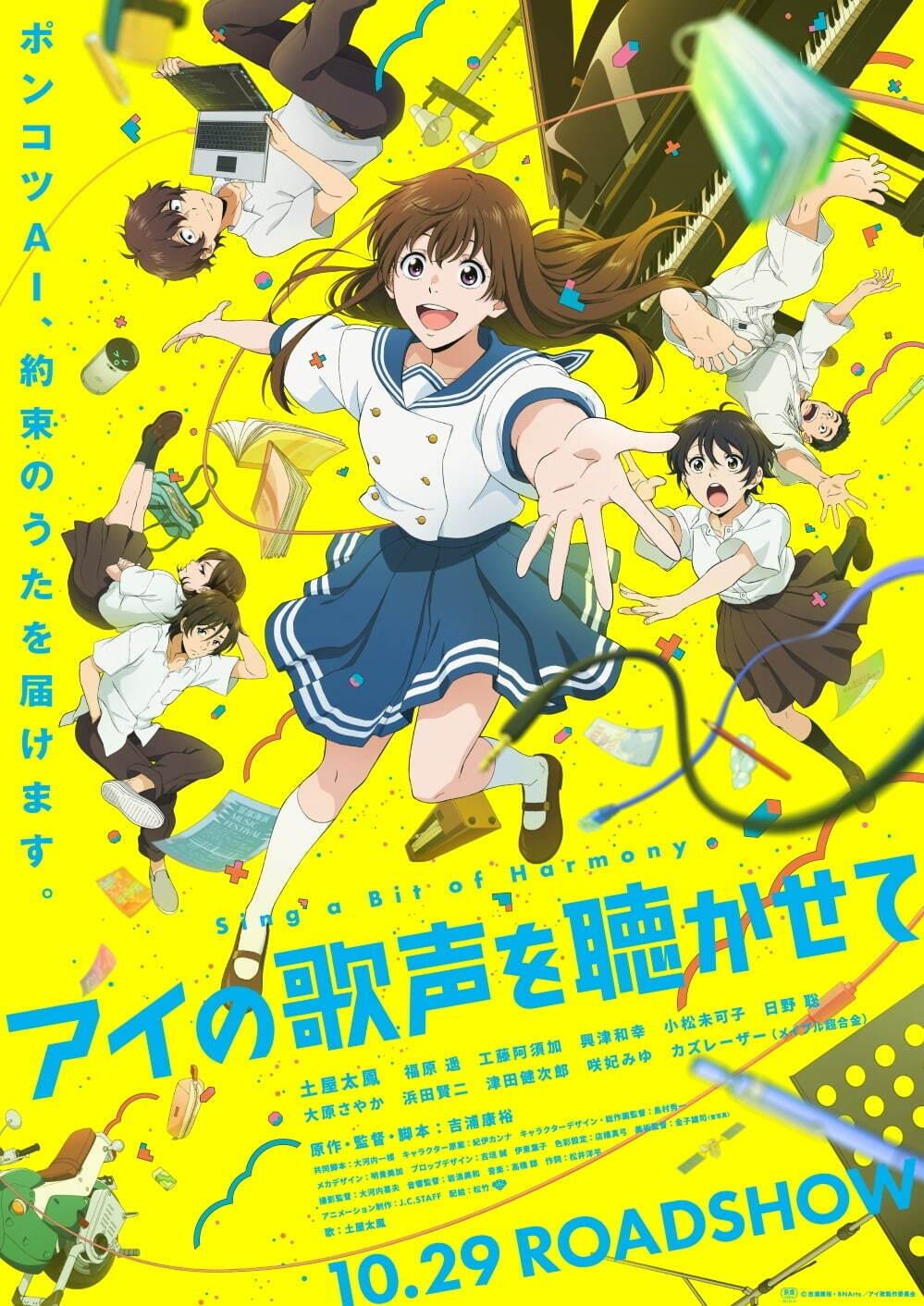
Onosume
Director Yasuhiro Yoshiura (Time of Eve, Patema Inverted) returns to the big screen with a film that combines elements from his previous work, particularly the focus on artificial intelligence featured in Time of Eve, with heavy influence from films such as Disney’s Frozen, to create a piece that Jonathan Clements describes as “Glee meets Ghost in the Shell” which is perhaps the best description anyone could give it.

The story focuses on high school girl Satomi and her emerging group of friends, who are brought together through their interactions with Shion, a humanoid AI robot developed by Satomi’s mother, Mitsuko, who is a talented AI developer working for the large technology company that drives most of the experimental autonomous city that they live in. While AI and robots are present in all aspects of daily life, the level of the technology is generally on par with what is available in real life although substantially more widespread, from smart homes to autonomous vehicles and cleaning robots. What the world hasn’t seen however, is an AI that can behave exactly like a human, and Shion is about to change that fact as she has been designed to look and behave just like your average 16-year-old girl. She is installed as a student at Satomi’s school as a final test to see if she can fool everyone into thinking she is human, although if she’s found out then the project will be terminated.
Of course, Shion’s cover is blown on her first day as she gets into an incident and has her robotic innards exposed. Wanting to protect her mother from losing her job, Satomi swears her classmates to secrecy and secures their help in keeping the fact that Shion is an AI robot hidden from the rest of the school. This is tricky enough when Shion goes all-out singing and dancing and making a name for herself, but becomes even more so when it becomes apparent that someone behind the scenes doesn’t want this test to succeed.
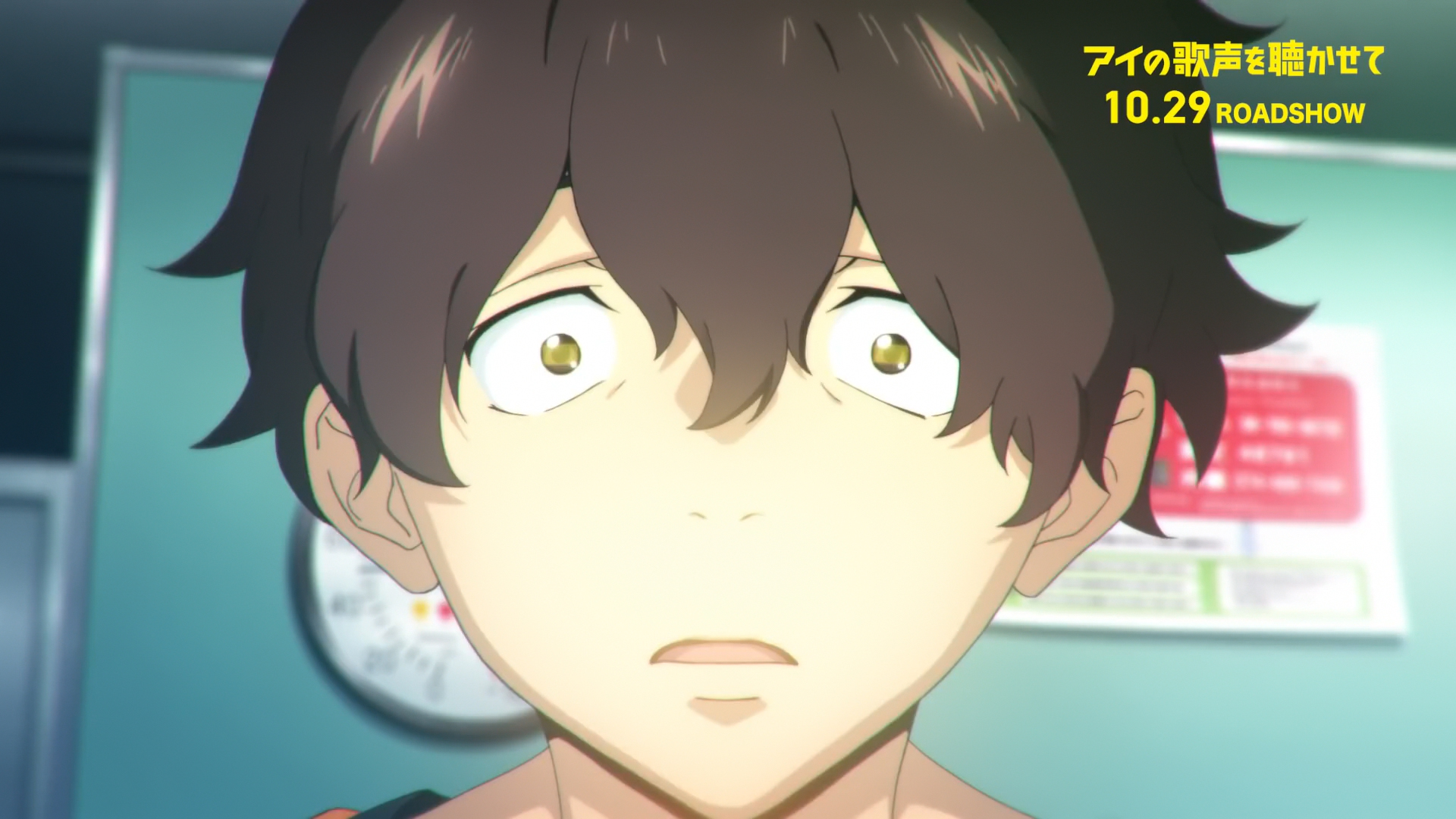
On the surface, this film is a fun and frolicking high school drama that focuses on the developing friendships and relationships between the main cast of characters, as each of them muscles through their existing misunderstandings and grievances, helped along the way by Shion pulling them into a variety of hijinks that facilitate their growth. With high school dramas being very much part and parcel of the anime industry there’s not too much new here, which on its own would be a weakness, but it manages to carve a standard template into its own thing thanks to the engaging characters and the cheesy musical numbers that are peppered throughout the film. Both give it lashings of comedy that really jelled with the Edinburgh audience, everyone laughing along to the dumb antics and being properly entertained by the music. The ongoing plot thread about Shion (and Satomi for that matter) being highly influenced by the in-universe equivalent of Frozen also seemed to go down well, or at least everyone seemed to get the joke.

There are some romantic elements in here too, which help bind the characters together in addition to using Shion to establish the group of friends and they’re handled really well. Satomi and her childhood friend and AI nerd Touma both have their eyes on each other, but an incident from their childhood has kept them apart, Aya and Gocchan are a couple going through some rough times, while judo club captain Thunder gets pulled towards Shion herself in perhaps the best scene of the film that turns judo practice into a beautifully animated dance sequence. It was just great to see each of them bond and come together in a variety of highly entertaining ways, and it certainly made that side of the film feel very accomplished.
Underneath all of that there are some more science fiction-oriented plot threads around the threat that a humanoid AI poses to humanity, as well as looking at some of the shady working conditions at big corporations, which form the threat that takes the film through its latter half or so. There are some interesting ethical questions asked here which do pull the film towards that Ghost in the Shell vibe, but they aren’t really tackled in as great a depth as in more well-known pieces of dystopian cyberpunk science-fiction. In the context of the film overall though, I think it works fine, and the human qualities shown by Shion earlier in the film really drive you to want her to survive, making the endgame very satisfying, although it is a little bit silly.
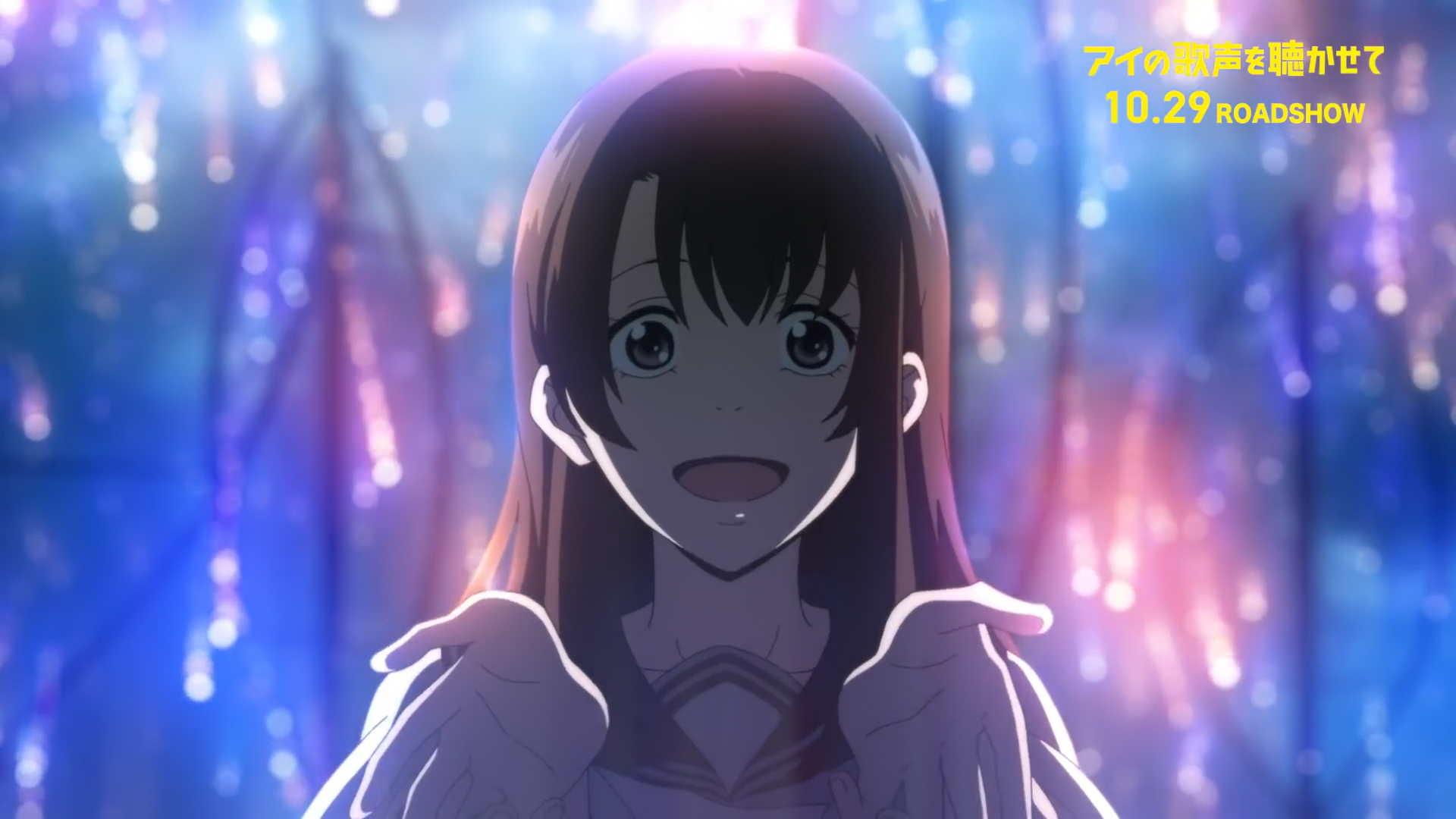
And I think that’s where my overall impressions lie. It’s a very silly but entertaining film that works really well when played in front of a cinema audience that can really get the tone that the film is going for, making it no surprise that it scooped up the audience award at the festival. Some elements would struggle to stand on their own if taken seriously, but it has enough humour and heart to get around that. While it’s not a masterpiece and certainly not Yoshiura’s best, I had a lot of fun with this film and would recommend seeing it when it becomes more widely available.
Over the Sky

Onosume
Where in the world to start with Over the Sky? This film, also known as Kimi wa Kanata and directed by Yoshinobu Sena, was the most polarising film of the festival that had a lot of people coming out of it screaming, “What did I just watch?!”.

The story follows Mio Miyamasu, a high school girl who is in love with her childhood friend Arata Kishimoto, but despite hanging out with him a lot has yet to tell him how she truly feels. When her friend and classmate Madoka reveals to her that she is also in love with Arata, Mio becomes jealous but is unable to put her claim on the guy she wants. Filled with regret, Mio begins to panic about Madoka making a move and rushes out on her bicycle in the middle of the night only to be involved in a road traffic accident.
While Mio initially carries on life is normal, it’s evident that something is a bit off, and she soon finds herself transported to another world. Here she meets Gimon, a plushie she owns that has come to life, and Kiku-chan, a young girl in a kimono, who must now guide her through this unfamiliar world as she strives to return to reality.
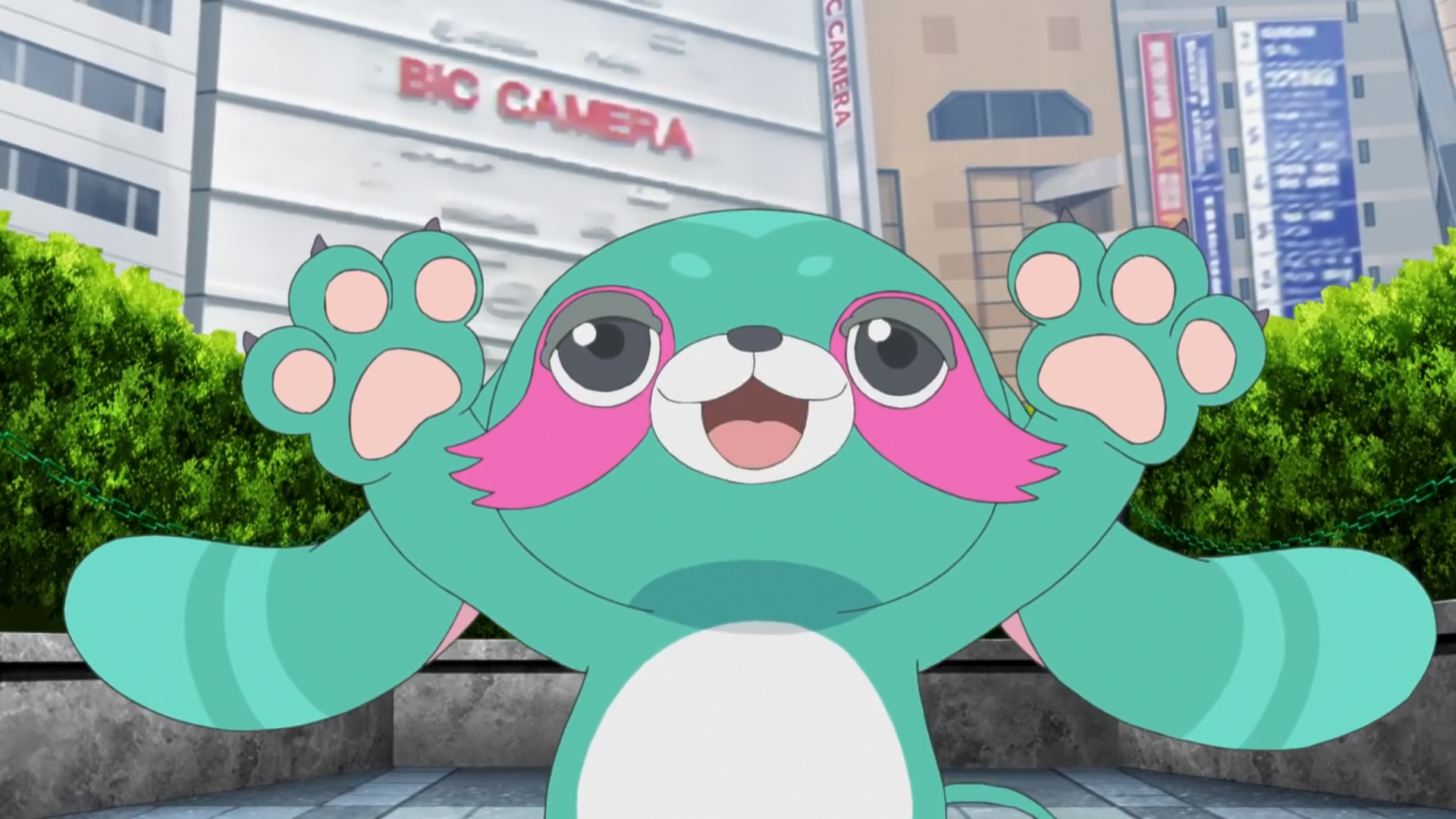
While I wasn’t a really big fan of this film, I hesitate to completely trash it as there is the presence of something good in here. The idea of finding yourself in a state of limbo and trying to cling to life by overcoming your darkest fears is an interesting one, and certainly gives space for Yoshinobu to lay out his ideas on the afterlife as well as other spiritual and supernatural topics (and as a few fellow viewers commented, could be compared to films funded by a certain religious cult). Yet anything that he is trying to seriously say unfortunately gets lost in a set of confusing and jumbled set pieces and is bogged down by a set of uninteresting characters.
The entire setup for the plot is rather typical and can be found done better elsewhere, and while Mio does show some growth towards the end of the film, she spends most of it running away and as a person she doesn’t have any particular depth. We don’t really know much about her apart from her love for both the old granny that used to run the store at the local shrine, and her pet goldfish. Main love interest Arata is the more interesting character here and it’s a shame the focus of the movie isn’t on him, as I enjoyed his backstory of being in a family with supernatural powers that allow them to interact with those whose souls end up in this limbo state. While he does try to save Mio, his efforts don’t have any real effect on the final outcome, which, although it avoids Mio from becoming too much like a damsel in distress, probably extends the running time of the movie for a good twenty minutes longer than it needed to be.
There’s the attempt at creating a villain with the addition of Mogari (voiced by popular Japanese actor Naoto Takenaka), who is attempting to keep Mio’s soul in limbo and send her on to the afterlife, but he’s a cheesy pantomime villain at best and a certain sequence where he turns into a monster just doesn’t make any sense in the larger context of the film. It often felt like Yoshinobu had taken elements of various popular anime films and smashed them all into one and none of it really worked. Oh, and remember Madoka? Well, she becomes irrelevant to the story quite quickly and is forgotten about after her initial appearance.
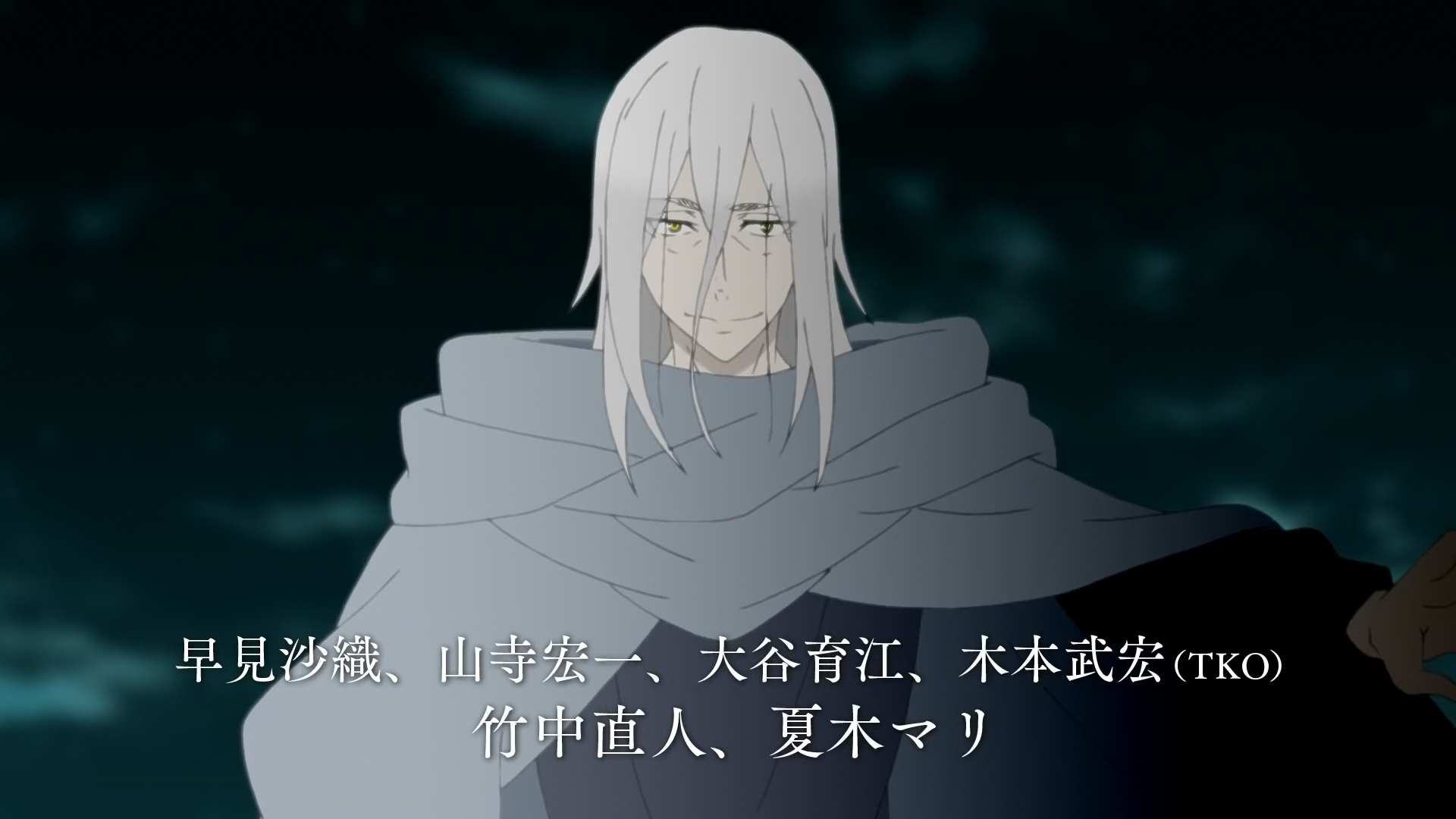
It doesn’t particularly look great either, with the director himself admitting he had a limited budget to work with. There are plenty of still frames used throughout, and effects certainly looked cheap compared to other films that were showing at the festival (the difference between this and Belle for example, which was lauded for its beautiful visuals, is like night and day). The art style used in some parts of the limbo world does help disguise things a bit, but it’s overall not something suited for a cinema-sized screen.
Despite all this, with the right audience it does tread into “so bad it’s good” territory and can be a serviceable piece of entertainment, as the Edinburgh audience certainly got a laugh out of its weirdness. Comments after the fact focused on what the director could do with a bigger budget and maybe a script not written by himself, and I kind of agree in that there’s some potential there, as if the Q&A session is anything to go by, the guy is certainly very enthusiastic about his work. This got more laughs than the actual film did due to Yoshinobu going into a very detailed, but still wishy-washy commentary about it, which was so long that a lot of it had to be cut out to make it a suitable length to show in the cinema.

Overall, this certainly wasn’t my thing, and I would say this is probably the worst film at this year’s festival, but at the same time it’s the one that is probably going to be remembered the most just because of how weird it was. With the right audience it can be enjoyed and heckled at – just remember to leave your brains at the door.
Arbalest
I’m not really sure what to say about Over the Sky, to be honest. If I were to put my thoughts into a few words I think simply it would be: it’s a mess of a film. Yeah, I think that works.
Over the Sky has a lot of interesting ideas that could have worked with a bit more coherency to what was put together, and that’s noticeable if you do opt to watch the film after reading all this, but it really just isn’t put together well enough to let them shine through and change this from ultimately a bad film, into an okay or good film. The film’s premise of Mio being whisked to another world definitely wouldn’t sound new or interesting to anyone, but it at least does do a bit differently here when you look further into the film and that’s okay, honestly. My concern really comes after the transportation to another world more than than what came before it.
A lot of the film feels like a lot of ideas and concepts meshed together until you get something that sticks, as if the director really wanted to capture something, but never really saw any of them through until the end. This in turn caused a lot of plot holes to form very quickly which do dampen the film just that bit more. We keep getting glimpses of a history the two main characters have with each other only to never really get the satisfaction of actually seeing what happens or properly learning what goes on. What we get instead is that moment of “oh, is that all we’re getting?” as a way to close off a story point that feels like it was forgotten about until then.
I want to say the film was so bad it’s good, but when you look back over it, I think if you watched this on your own, you wouldn’t get the same impression as we did when you watch it with a reasonably full cinema laughing at what are meant to be some serious moments. We have moments of some characters just randomly screaming, which you are given no warning for, or reason for. And one particular moment of something like this had the cinema in hysterics. It’s worth noting that Mio and Arata’s VAs were debut roles, and it’s quite obvious in the way they come across, especially for Mio, that I think it’s sadly made the particular scenes mentioned above all the worse. Arata’s VA didn’t fair much better either.
I don’t feel like I’ve really been able to do much better than the film, to be honest, it’s a bit of a messy set of thoughts, but it’s still potentially a good bit of fun with the right crowd. Though I say that, it’s definitely not the worst film I’ve seen at the festival, I think our lovely Purple Cat, Budori Gusuko will forever hold that title, but it definitely has a spot at the bottom of the list, near Psychic School Wars for me personally.
Fortune Favors Lady Nikuko
Jury Award Winner
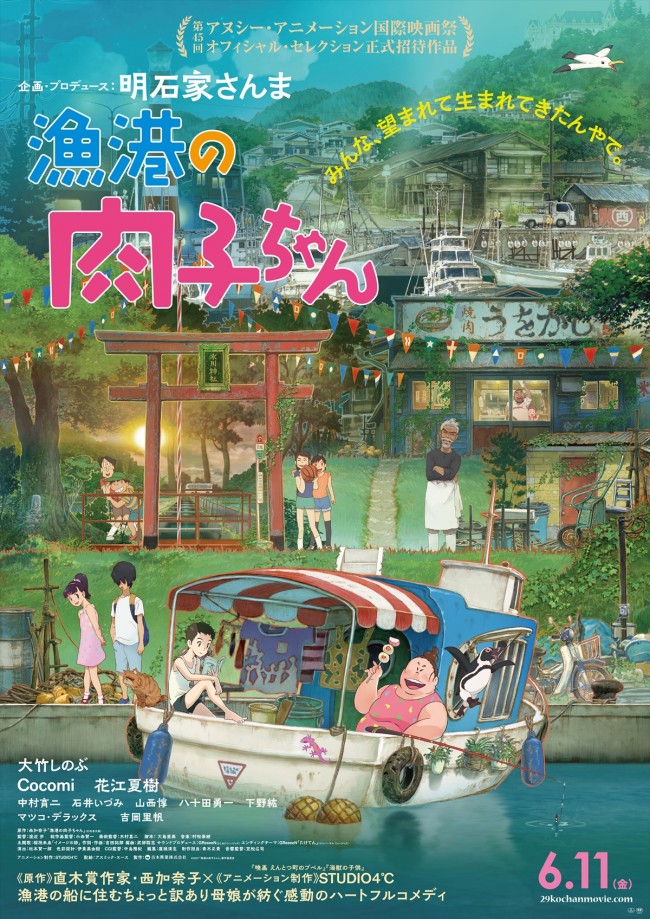
Josh A. Stevens
In a surprise twist that absolutely no-one was expecting, this year’s coveted “Golden Partridge” Jury Award went not to Mamoru Hosoda’s Belle, which famously won over the prestigious Cannes Film Festival audience with a 14-minute standing ovation. Instead, after an initial deadlock, the jury’s applause went to Fortune Favors Lady Nikuko, a curious little yet big film from Studio 4°C and Ayumu Watanabe. When I saw their previous film Children of the Sea at the festival two years prior, I admittedly scored it straight down the middle with a 3 simply because my brain overheated trying to comprehend the existential wonder of its last act, and rewatches haven’t helped on that front. If you were in the same boat, rest assured that Fortune Favors Lady Nikuko is a far more accessible and understandable film! Is it Golden Partridge worthy though? Let’s find out.
Fortune Favors Lady Nikuko is the story of a mother and daughter who live in a houseboat in the harbour of a small, run-down Japanese town. Nikuko is larger than life in both physique and personality, being bubbly to the point of embarrassment for Kikuko, who is quieter and in that awkward time between childhood and adolescence. Despite the title of the film, our focal point is actually the younger Kikuko, who the festival’s jury chairman Dr. Jonathan Clements is eager to point out is an unreliable narrator (indeed, I’m not sure how reliable I’d find someone who imagines penguins talking about murder). Kikuko paints a particular picture of her mother as a bit of a childish glutton, but like with all children, it soon becomes clear that Kikuko doesn’t know the full picture behind the cheerful veneer of her Totoro-esque caretaker.
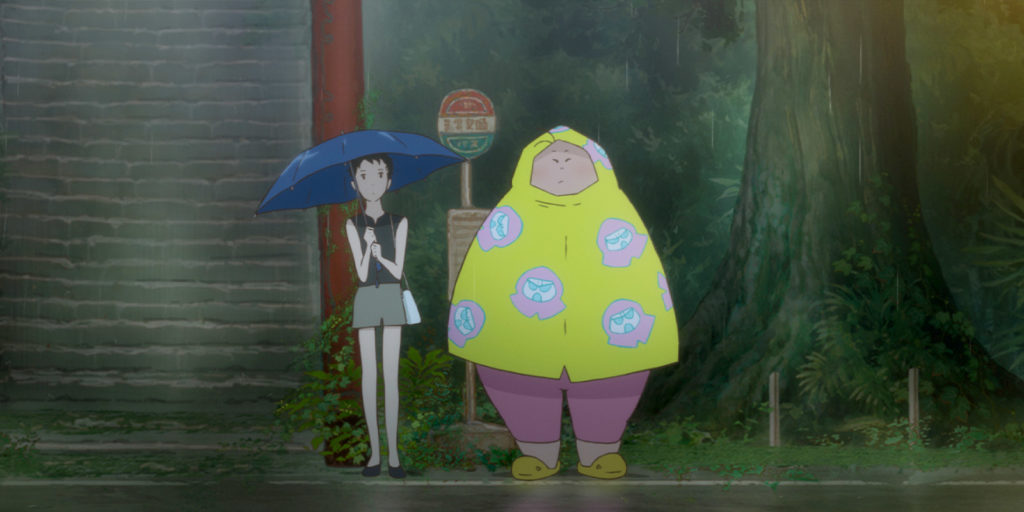
To me at least, this film feels like a celebration of smaller, ordinary lives. Fortune Favors Lady Nikuko isn’t about anyone famous or trying to save the world. Nikuko and Kikuko are just people like us, living lives like us whose stakes may not cause Armageddon, but are still huge for them. That gives the film a special charm, especially because it does what it does really well. Dodging the pitfalls of its premise, Kikuko never feels bratty, nor does Nikuko’s cheerfulness outstay its welcome.
Where their story becomes larger than life is in its presentation, with regular bursts of whacky animation and visual metaphors. Some of these jokes about Nikuko’s large stature can border on childishly fatphobic at times, however. To be honest, that’s part of a larger issue of mine about the film’s opening minutes perhaps being a bit too juvenile, but once Fortune Favors Lady Nikuko hits its stride, it becomes a wholesome yet captivating story.
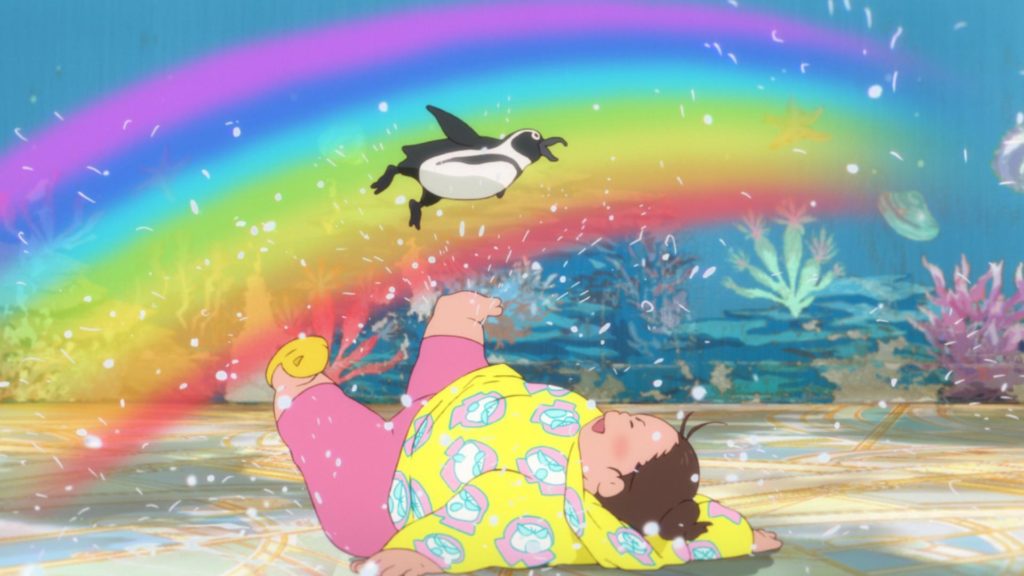
I must confess that going in, I didn’t expect much from Fortune Favors Lady Nikuko – especially given how I’d heard literally nothing about it before. I was also a bit salty that an ‘In Competition’ slot was taken from Pompo the Cinéphile to accommodate the late addition of Belle (check our Festival Highlights article for my thoughts on Pompo!). However, Fortune Favors Lady Nikuko was a welcomed surprise and on balance, I think that this film knows what it wants to be, and does that better than any of the other films in competition this year. A surprising, but deserving winner.
Belle
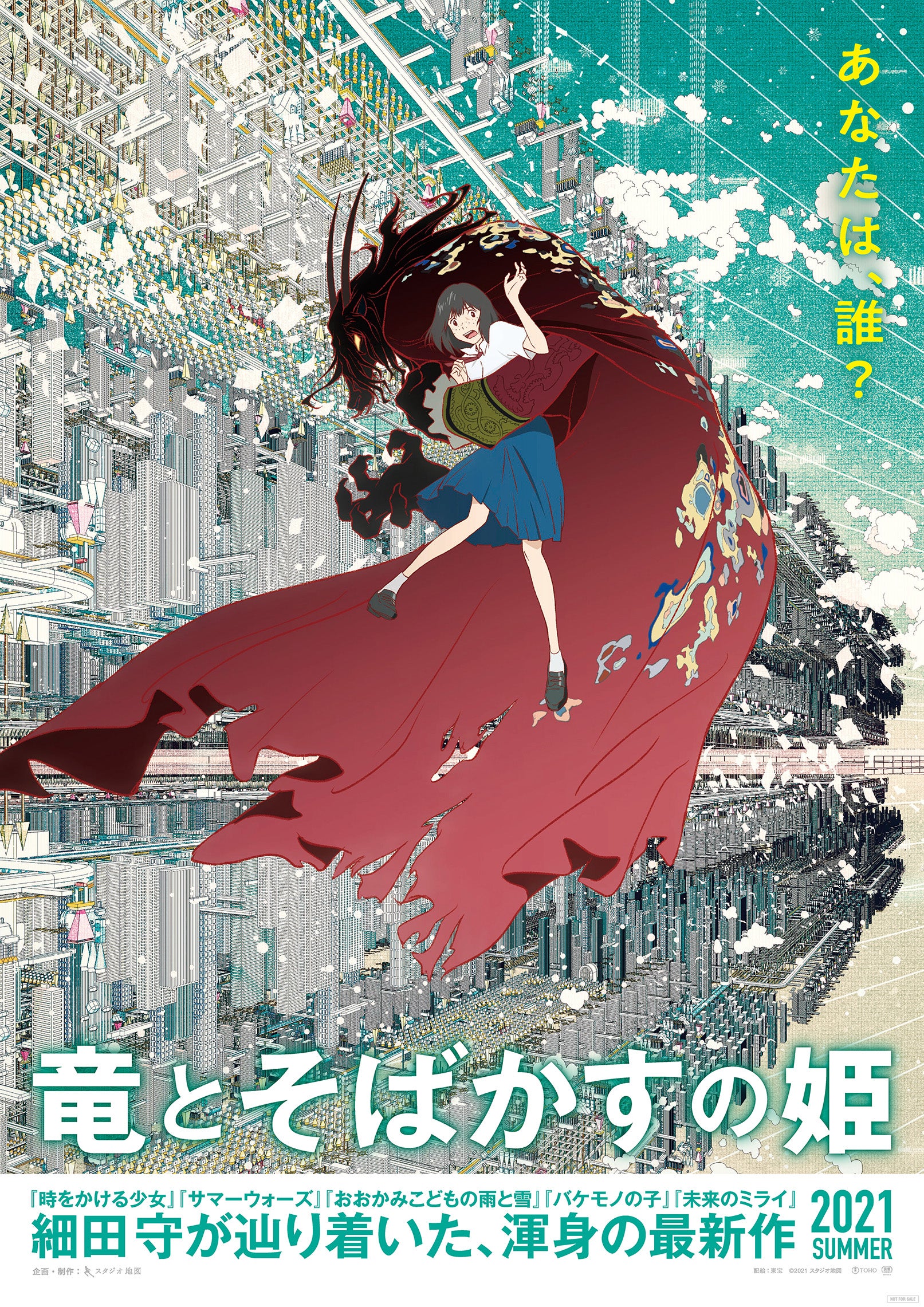
Arbalest
It doesn’t need much introduction, honestly, however Belle by Mamoru Hosoda was easily the most hotly anticipated film of the festival when it got announced as the Mystery Film in Edinburgh back in September. While it may not have won the Jury or Audience Awards, how was it for me? This film left a strong enough impression that I still dither between this and The Deer King as my favourite from the festival. I didn’t expect to enjoy Belle as much as I did when I sat myself in my seat in the filmhouse, but I left with it leaving one hell of an impression on me.
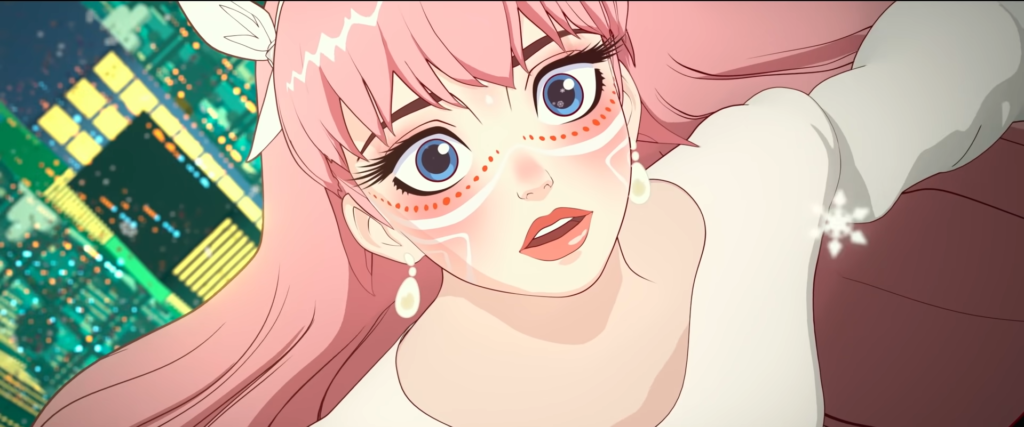
Belle feels like Hosoda’s first “global” release. And how this film flows and comes to its conclusion in its final act really show that well. By this I mean that a lot of his previous films felt like they where more what you would expect of a Japanese animated film, but this felt like it really wanted to appeal to a broad audience, one with a story of how the internet, for all its flaws and problems, can really give you a second chance at life, and help you come to terms with who you are. A message, I think, that is very global and one that isn’t shared often enough.
Belle sees the story of Suzu, a girl in high school who when she was young had a love for music, making it and singing it. She did this with her mother until one day her mother saved a child from a raging river and passed away. The event caused Suzu to think her mother abandoned her, and in turn she couldn’t bring herself to sing or make music again. Suzu then finds U, a virtual world where you can create a second life and begin anew. Upon creating her avatar, she becomes “Belle” and learns to sing once more. Mamoru Hosoda has mentioned before and did during his Q&A that was recorded for the Edinburgh International Film Festival that he does take inspiration from Beauty and The Beast in his works, and that is very clear here, especially when we see the introduction of “The Dragon”. There is a “Disney” feel to a lot of the film, more specifically to the virtual world segments that we see. The Beauty adored by all; The Beast hated by everyone.
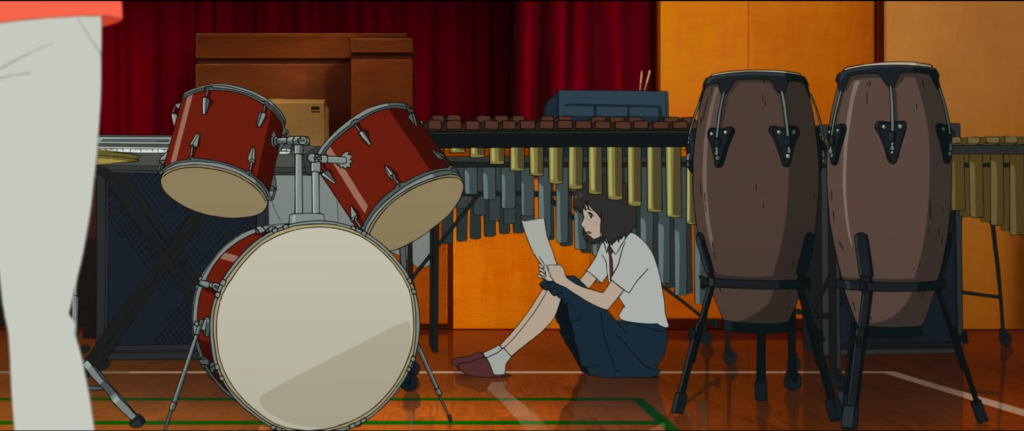
What I love about this film, though, is how it really does show the power of the internet and being given a “second chance”. We are all entitled to that second chance at life, and a life in the digital world may seem strange to some, but it definitely has the influence to shape you into someone that can take that step forward to what you want to achieve and be confident again. Suzu’s life gets turned round when she becomes Belle, and while she does a good dose of trying to hide it from everyone in real life, you can still see the confidence it instills in her as the film goes on. It’s refreshing to see Hosoda’s take on the internet when he does cover it in his films because he doesn’t want to make it all gloomy and grim when approaching the subject. And it’s something I can honestly relate to as well; I wouldn’t be where I am now without the connections and lessons I learned about myself online.
I feel I do want to touch upon a smaller subject here. Whether deliberate or not I don’t know, but there is a bit to be said about single parents bringing up their kids. It’s shown throughout the film how Suzu and her father just can’t connect anymore, and while it’s not really touched on much, that in itself shows how tough this can be. Suzu’s father never seems to know how to approach her, and likewise the other way round. They never eat together, they never talk much, but at its heart, you really see just how much her father truly cares for her in these small interactions. It’s small and subtle, but it really shows how much love there is for her here. There are a few scenes near the end of the film I won’t go into for spoilers that contrast really well to Suzu’s situation with her father that I think are worth mentioning, as they show two fairly polarising sides of single parenthood, one with the distant care that Suzu has with her father, and then how things can go to a different extreme on the other.
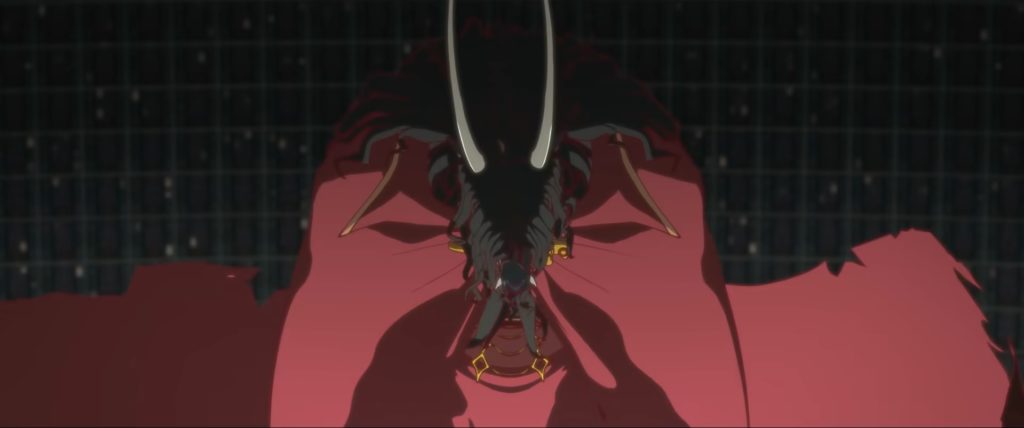
Lastly, I can’t really give an impression on the film without mentioning the music and the stunning visuals. Hosoda’s vision for “U” is spectacular, every person’s avatar being unique, varied and so full of character. I can see why some say the world itself feels “empty”, but I didn’t see it as that. I saw it as a blank canvas for you to create your second life in as the vision U sets itself to have. The CG work here is stunning, and when you see the costume changes Belle has during her performances, it really shines through even more. Even in the real world, where the colours feel more true to life, muted in some ways, it’s a wonderfully crafted piece of animation all round. The music and the songs performed are magical as well. At the heart of them, they show Suzu’s innermost thoughts, her drives and fears, her confidence, and at times her nerves. It’s such a solid film for me that I can’t recommend it enough.
Over the Sky will be screened as part of Sheffield Loves Anime between 19-21 November, 2021, and in selected Showcase and Picturehouse cinemas between 4-5 December, 2021 as part of the We Love Anime touring program.


